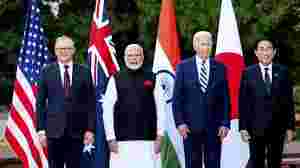Strategic Importance of Quad Countries and Quad Summit: A Comprehensive Analysis

The Quad countries—the United States, India, Japan, and Australia—form a strategic coalition known as the Quadrilateral Security Dialogue (Quad), aimed at promoting security, prosperity, and democratic values across the Indo-Pacific region. Initially conceptualized in 2007, the Quad has evolved into a robust platform addressing mutual concerns like maritime security, climate resilience, health cooperation, and emerging technologies. At the center of this alliance lies the Quad Summit, a critical forum for the leaders of these nations to discuss strategic priorities and policy collaborations. This article explores the history, objectives, and future potential of the Quad, while highlighting the significance of the Quad Summit in shaping global geopolitics.
Origins and Evolution of the Quad Grouping
The Quad began as a response to the 2004 Indian Ocean tsunami, where the four nations coordinated humanitarian relief efforts. The success of this cooperation planted the seed for a more formal strategic dialogue. However, geopolitical hesitations caused the initiative to stall temporarily. It was revived a decade later amidst growing concerns over regional security dynamics, especially the rise of Chinese assertiveness in the South China Sea and broader Indo-Pacific region.
Over time, the Quad countries moved beyond an informal alignment into a structured diplomatic mechanism. Today, the Quad is seen as a pillar of the Free and Open Indo-Pacific (FOIP) strategy. Each Quad country brings its unique strengths to the partnership—India's strategic geography and growing economic clout, the U.S.' extensive security network, Japan’s technological prowess, and Australia’s role as a regional stability anchor.
Quad Summit: The Core of Strategic Dialogue
The Quad Summit is one of the most significant features of this partnership. These high-level meetings, whether virtual or in-person, allow the leaders of the four nations to address regional and global challenges jointly. The first-ever virtual Quad Summit took place in March 2021, followed by the first in-person summit in Washington, D.C., in September 2021. Since then, the platform has become more regular and institutionalized, reinforcing the seriousness of this partnership.
The Quad Summit is not about forming a military alliance, but rather building functional cooperation in areas like:
- Maritime Security: Ensuring the Indo-Pacific remains free from coercive influence and open for trade.
- Supply Chain Resilience: Reducing dependencies in critical sectors like semiconductors and pharmaceuticals.
- Emerging Technologies: Collaborating on AI, 5G, and cybersecurity.
- Climate Change: Supporting clean energy initiatives and disaster resilience.
- Healthcare: Partnering on vaccine production and distribution, especially during the COVID-19 pandemic.
Strategic Significance of Quad Countries
1. United States
As a global superpower, the U.S. sees the Quad as essential to counterbalance China’s growing influence. Washington's Indo-Pacific strategy underscores the value of alliances and partnerships, and Quad is a cornerstone of this approach.
2. India
For India, the Quad strengthens its strategic autonomy while aligning with its vision of a multipolar Asia. It also provides a platform to project power in the maritime domain and safeguard its interests in the Indian Ocean.
3. Japan
Japan initially proposed the concept of a "Quadrilateral" dialogue and remains deeply invested in promoting a rules-based order in the Indo-Pacific. Tokyo’s diplomatic and technological initiatives play a pivotal role in Quad initiatives, especially in digital connectivity and quality infrastructure.
4. Australia
Australia’s inclusion in the Quad highlights its evolving strategic posture, especially as it navigates challenges from Chinese economic coercion. Canberra is also central to Quad's goals in the South Pacific.
Quad's Impact on Global Geopolitics
The Quad represents a shared commitment to what U.S. President Joe Biden has called "democratic values and a free and open Indo-Pacific." Critics often label the Quad as a containment strategy against China, but member countries insist it's about fostering cooperation and dialogue, not confrontation. The Quad's proactive stance on critical technologies, infrastructure, and maritime security has also prompted other regional actors to support or align with its objectives.
Moreover, initiatives like the Quad Vaccine Partnership—which aimed to deliver over a billion COVID-19 vaccine doses—showcase the partnership’s soft power potential.
Challenges and the Road Ahead
Despite its growing significance, the Quad faces challenges. Divergent national interests could cause friction in coordinating responses to crises. India’s non-aligned tradition sometimes conflicts with more Western security priorities. Additionally, China views the Quad with suspicion, often calling it an "Asian NATO," which could escalate regional tensions.
Yet, successive Quad Summits have reinforced that this group is here to stay. With continued investment in strategic trust, multilateral cooperation, and practical projects, the Quad is likely to shape the future of the Indo-Pacific region.
Conclusion
The Quad countries and the Quad Summit represent a powerful convergence of democratic nations committed to regional stability, economic cooperation, and shared values. As the Indo-Pacific continues to emerge as the center of global activity, the role of the Quad will likely expand—from strategic dialogues to tangible action. Whether through vaccine diplomacy, cybersecurity frameworks, or climate commitments, the Quad’s influence is poised to grow in the years ahead.
- Art
- Causes
- Crafts
- Dance
- Drinks
- Film
- Fitness
- Food
- Jocuri
- Gardening
- Health
- Home
- Literature
- Music
- Networking
- Alte
- Party
- Religion
- Shopping
- Sports
- Theater
- Wellness



